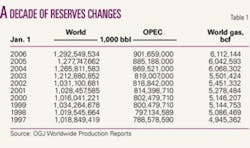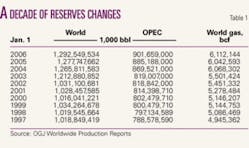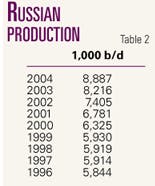Estimated worldwide oil and gas reserves increased slightly from a year ago, according to Oil & Gas Journal’s annual survey. In 2005, production of crude oil and lease condensate edged up nearly 1% from a year earlier.
Click here to view the Worldwide Production Survey in pdf.(35 pages)
Reserves estimates for crude oil and natural gas are both up 1.2% from last year’s survey (OGJ, Dec. 20, 2004, p. 18). Total proved oil reserves are now estimated at 1.292 trillion bbl, while the world’s gas reserves are 6.112 quadrillion cu ft.
The share of the world’s oil reserves in member countries of the Organization of Petroleum Exporting Countries grew slightly from the previous survey and now stands at 69.8%.
OGJ bases its reserves estimates on surveys of official sources, requesting data on proved reserves. Because most countries do not reassess annually, some estimates in this survey do not change each year.
Reserves changes
Most revisions in the current survey are small. Some of the countries with new figures had not updated their reserves reports in several years.
Changes to OPEC members’ reserves estimates are little changed from a year ago, except for Indonesia’s. The estimate of gas reserves there has been increased 8%, but Indonesia’s oil reserves estimate is 8.5% lower.
Outside OPEC, some of the larger percentage changes to reserves estimates are for Morocco, Albania, Taiwan, and Bangladesh, where reserves totals are low. Morocco reported that its remaining proved crude and condensate reserves were recently reevaluated to be 1.069 million bbl, and the new estimate of its gas reserves is 60 bcf.
Denmark reported a large decline in gas reserves due mainly to production. The most recent estimates put Denmark’s proved gas reserves at 2.786 tcf and crude and condensate reserves at 1.3 billion bbl.
The latest estimates reported by the Canadian Association of Petroleum Producers (CAPP) indicate a 2.3% increase in Canada’s conventional oil reserves to 4.7 billion bbl as of the end of 2004. Gas reserves were nearly unchanged at 56.58 tcf, according to CAPP.
The Alberta Energy and Utilities Board reported that remaining established reserves of bitumen in Alberta have been reduced from 174.5 billion bbl to 174.1 billion bbl due to 2004 production.
The most recent proved oil and gas reserves figures released by the UK Department of Trade and Industry (DTI) show 10% declines in both categories. With 2004 liquids production at 718 million bbl, the UK’s proved reserves replacement was 431 million bbl. These additions to oil reserves arose from a greater confidence level following technical and economic reassessments, which resulted in reserves moving to proved from probable in a number of fields, DTI reported.
US reserves
According to the latest estimates by the US Energy Information Administration, US crude oil reserves declined for the second year in a row, while total US gas reserves rose for the sixth year in a row.
US crude oil reserves during 2004 decreased 2.4% to 21.37 billion bbl. New field discoveries of oil reported last year were the lowest in 12 years. Operators replaced only 71% of production with new reserves.
EIA reported that the majority of last year’s oil discoveries-617 million bbl-came from extensions to fields in Texas, Alaska, and the federal areas of the Gulf of Mexico.
New field discoveries accounted for 33 million bbl of crude oil reserves additions, 27 of which were small discoveries in federal gulf waters. And new reservoir discoveries in old fields added 132 million bbl, which was 31% more than during the prior year.
Four areas account for over three fourths of proved oil reserves in the US: Texas holds 22%, Alaska 20%, the federal gulf 19%, and California 16%.
The latest estimates show that US gas reserves moved up 1.8% last year to 192.5 tcf.
Increased onshore gas drilling in 2004 resulted in large reserves additions to known fields, EIA reported, but discoveries of new gas fields were the lowest in 12 years. Field extensions added 18.2 tcf of gas to the US total, while new field discoveries added 759 bcf during 2004. New reservoir discoveries in old fields added 1.2 tcf to total US gas reserves.
Due to exploration in South Texas and extensions of existing fields in the Permian basin and Newark East field in the north-central part of the state, proved gas reserves in Texas increased 9%, more than additions in any other state last year.
Production and proved gas reserves in the federal Gulf of Mexico declined last year, largely because of Hurricane Ivan. Reserves in this area were down 15% due to low new field discoveries and relatively large negative revisions to estimates.
Oil production
Worldwide oil production in 2005 averaged 71.8 million b/d, up from 71.2 million b/d a year earlier.
Oil production in Western Europe is estimated to have declined nearly 9%, with sizable declines in Norway and the UK.
In Africa, production climbed about 7%, with jumps in output in Algeria, Angola, Libya, and others. Nigerian oil production this year is estimated to have averaged 2.4 million b/d.
Preliminary estimates also show growth of about 4% in Eastern Europe and the former Soviet Union. Russian oil output is estimated to have increased to average 9.2 million b/d this year from an average of nearly 8.9 million b/d last year. Meanwhile, oil production in Azerbaijan increased by a third, while output in Kazakhstan was unchanged at an average 970,000 b/d.
OGJ estimates that US oil production this year declined 5.5% to average 5.12 million b/d. Some of the decline can be attributed to an unusually active hurricane season in the Gulf of Mexico, but US production has declined every year since 1991. Last year, US oil production declined 4.4%, according to EIA. ✦




